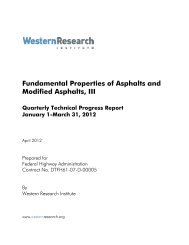Fundamental Properties of Asphalts and Modified Asphalts, III
Fundamental Properties of Asphalts and Modified Asphalts, III
Fundamental Properties of Asphalts and Modified Asphalts, III
Create successful ePaper yourself
Turn your PDF publications into a flip-book with our unique Google optimized e-Paper software.
SUBTASK 2-2.2. SUPPORT OF THE MECHANISTIC-EMPIRICAL PAVEMENT<br />
DESIGN GUIDE<br />
Statement <strong>of</strong> Problem<br />
The global aging system is a series <strong>of</strong> models that attempt to predict the change in binder<br />
viscosity in hot-mix asphalt (HMA) pavement with time <strong>and</strong> depth. These models are an integral<br />
part <strong>of</strong> the NCHRP 1-37A Mechanistic-Empirical Pavement Design Guide. The models were<br />
developed from an extensive database consisting <strong>of</strong> capillarity viscosity, <strong>and</strong> penetration <strong>and</strong><br />
s<strong>of</strong>tening point measurements converted to viscosity, over a broad range <strong>of</strong> temperatures [Mirza<br />
<strong>and</strong> Witczak 1995]. Christensen <strong>and</strong> Bonaquist [2006] modified the global aging system models<br />
to make use <strong>of</strong> rational rheological measurements <strong>and</strong> binder master curve parameters while<br />
maintaining consistency with the original models. They noted in regard to a part <strong>of</strong> their study,<br />
which employed the global aging system, that the results should be considered approximate,<br />
since “there are many questions concerning the accuracy <strong>of</strong> the global aging system.”<br />
WRI, also in 2006, evaluated how well the GAS models predicted the actual aging that occurred<br />
at the FHWA/WRI Arizona validation site [Farrar et al. 2006]. One <strong>of</strong> the main findings <strong>of</strong> the<br />
study was that oxidative aging occurring at the Arizona site was substantially greater than<br />
predicted by the GAS models, particularly in the top 13 mm <strong>of</strong> the pavement. Al-Azri et al.<br />
[2006] in an extensive investigation <strong>of</strong> selected Texas highway pavements concerning<br />
unmodified binder aging reported the level <strong>of</strong> hardening reached in pavement binders<br />
significantly exceeded estimated values calculated by the global aging system both at the<br />
pavement surface <strong>and</strong> at 125 mm below the surface.<br />
More specifically, the global aging system was developed based on laboratory tests <strong>of</strong><br />
conventional “S” binders. These linear or straight-line Class “S” asphalts were non-modified,<br />
<strong>and</strong> the authors <strong>of</strong> the global aging system (Mirza <strong>and</strong> Witczak) advised the global aging models<br />
should not be used for modified asphalts, Class “W” (waxy) or Class “B” (blown) asphalts. The<br />
S, B, <strong>and</strong> W designations were originally developed by Heukelom [1973] who observed the<br />
linear <strong>and</strong> nonlinear relationships <strong>of</strong> asphalts using the Bitumen Test Data Chart developed in the<br />
1960’s.<br />
In addition: (1) the global aging system does not address photo-oxidation effects on the surface,<br />
(2) the air void adjustment factor is based on limited data <strong>and</strong> considered “optional,” (3) the<br />
global aging system does not take into account sealer/rejuvenator, chip seals, or open graded<br />
friction course effects on pavement aging, <strong>and</strong> (4) the global aging system is not based on<br />
“fundamental” binder properties.<br />
Approaches<br />
The accuracy <strong>and</strong> possible modifications to the global aging system are being studied at WRI by<br />
analyses <strong>of</strong> data <strong>and</strong> materials from the FHWA/WRI validation sites <strong>and</strong> laboratory aging<br />
(RTFO <strong>and</strong> PAV). Analytical tests applied include infrared spectroscopy <strong>and</strong> dynamic shear <strong>and</strong><br />
bending beam rheometry <strong>of</strong> unaged <strong>and</strong> aged materials. Master curves <strong>of</strong> unaged <strong>and</strong> aged<br />
asphalts <strong>and</strong> age based shift factors are being studied to quantify age related changes.<br />
11





